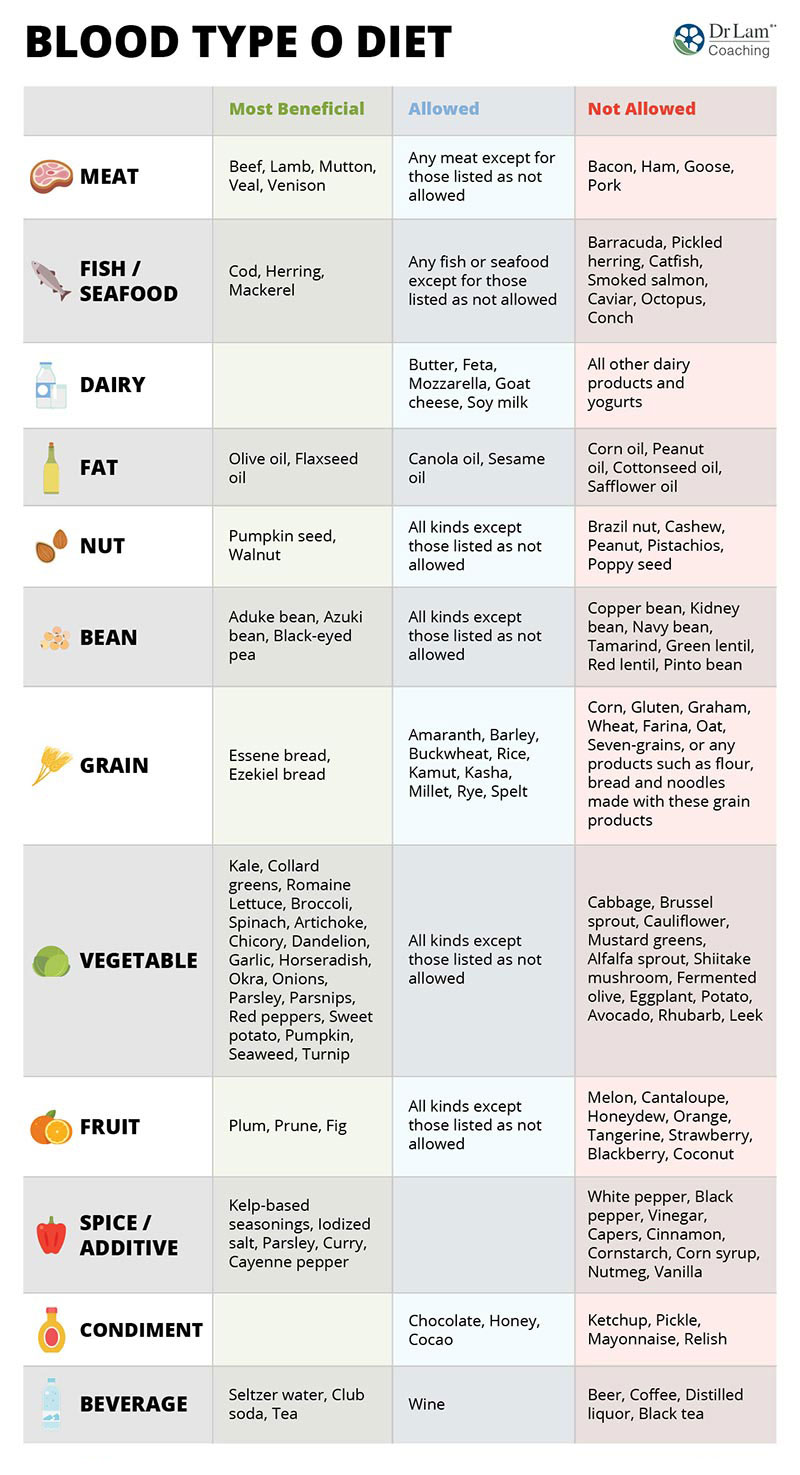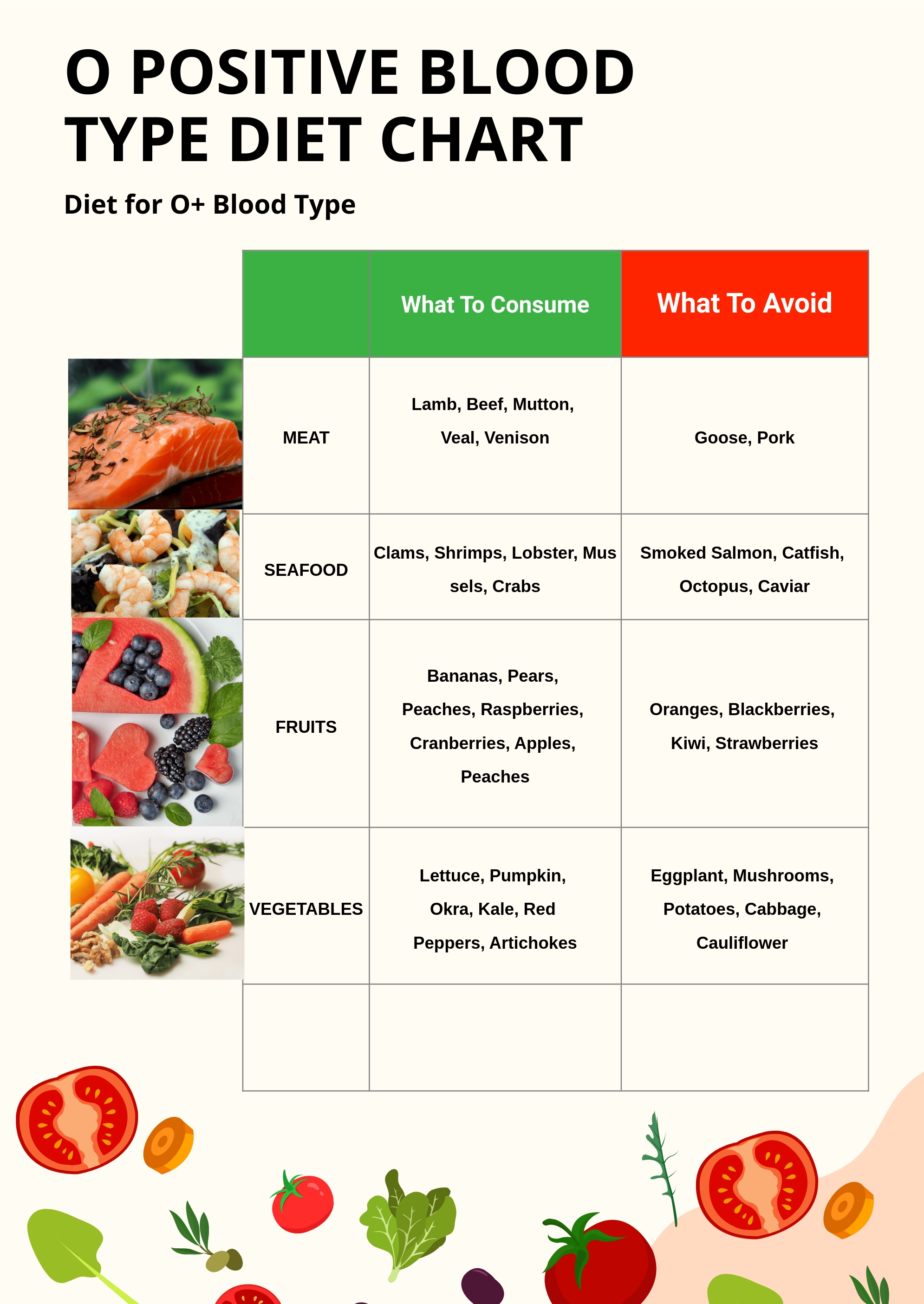Have you ever wondered if your blood type influences your health and well-being? For centuries, the concept of blood type diets has intrigued individuals seeking optimal health and wellness. The O-positive blood type, the most common blood type globally, is often associated with particular dietary recommendations. This article delves into the world of O-positive diets, exploring the scientific basis behind these claims and offering practical insights into incorporating blood type concepts into your lifestyle.

Image: www.drlamcoaching.com
Advocates for blood type diets believe that your blood type dictates how your body processes food and, therefore, impacts your overall health. The O-positive diet, in particular, emphasizes a protein-rich, meat-centric approach with limited carbohydrates. But is there scientific evidence to support these claims? Let’s embark on a journey to understand the scientific rationale and practical implications of the O-positive diet.
The History of Blood Type Diets
The idea of blood type diets traces back to the work of Dr. Peter J. D’Adamo, a naturopathic physician who popularized the concept in his book “Eat Right 4 Your Type”. D’Adamo proposed that different blood types evolved at different times in human history, each adapting to various environments and diets. According to his theory, individuals with O-positive blood type, considered the oldest blood type, are best suited to a high-protein, meat-based diet similar to that of our hunter-gatherer ancestors.
However, the scientific community has been cautious about endorsing this theory. While there’s evidence suggesting that blood type influences certain physiological processes, such as immune responses, a direct link between blood type and dietary needs remains elusive. Most experts recommend a balanced and personalized diet based on individual needs, lifestyle, and health goals, rather than solely relying on blood type.
The Core Principles of the O-Positive Diet
The O-positive diet emphasizes a protein-rich approach with moderate amounts of healthy fats and limited carbohydrates. Here are the key principles:
- Meat Consumption: The diet encourages the regular consumption of lean meats, poultry, and fish, emphasizing protein as a key source of energy.
- Fruits & Vegetables: While vegetables are encouraged, certain fruits like citrus are discouraged, as they are believed to cause digestive discomfort in O-positives.
- Dairy: Moderate consumption of dairy products is generally allowed, but some believe moderation in dairy is beneficial, especially for individuals with lactose intolerance.
- Grains: Grains are typically limited on the O-positive diet, with an emphasis on brown rice and quinoa. Avoidance of gluten-containing grains like wheat is often recommended.
- Legumes: Legumes are generally discouraged, as they are believed to be difficult for O-positives to digest due to their high lectin content.
Potential Benefits of the O-Positive Diet
While the scientific evidence backing blood type diets is limited, proponents of the O-positive diet highlight several potential benefits:
- Weight management: A protein-rich diet can promote satiety, potentially supporting weight loss or management.
- Improved blood sugar control: Limiting refined carbohydrates can help stabilize blood sugar levels in individuals with a predisposition to insulin resistance.
- Reduced inflammation: Some studies suggest that a diet rich in antioxidants found in fruits and vegetables (especially green leafy vegetables) can help reduce inflammation throughout the body.

Image: www.animalia-life.club
Considerations & Concerns
While the O-positive diet may offer potential benefits, there are also several considerations and concerns.
- Nutrient Deficiencies: A strict adherence to the O-positive diet that limits fruit intake, grains, or certain vegetables could lead to deficiencies in essential nutrients, such as vitamins, minerals, and fiber.
- Dietary Restrictions: The strict dietary restrictions of the O-positive diet might be challenging for some, particularly those with limited dietary access to suitable food choices.
- Lack of Scientific Evidence: The scientific basis for blood type diets remains largely unsubstantiated. While research on blood types and the digestive system continues, there’s insufficient evidence to concretely support the claims of blood type diets.
The O-Positive Diet in Practice: A Sample Meal Plan
Here is a sample meal plan for the O-positive diet, showcasing balanced options that incorporate the key principles:
- Breakfast: Scrambled eggs with spinach and grilled chicken sausage.
- Lunch: Grilled salmon with quinoa and roasted broccoli.
- Dinner: Beef stir-fry with ginger, garlic, and green beans.
Diet For O Positive Blood Type Pdf
Key Takeaways
The O-positive diet emphasizes a protein-rich, meat-centered approach with limited carbohydrates. While it may offer potential benefits like weight management and improved blood sugar control, the scientific basis for its claims remains limited. Ultimately, the best approach to diet is a personalized one tailored to your individual needs, health goals, and cultural preferences. Consult with a registered dietitian or healthcare professional for personalized guidance on diet and nutrition.
Remember, a balanced and healthy diet, coupled with regular exercise, is the foundation for optimal well-being. While fascinating, the O-positive diet should not replace the advice of healthcare professionals. Embrace a holistic approach to your health, incorporating diet, exercise, stress management, and adequate sleep for overall well-being.





